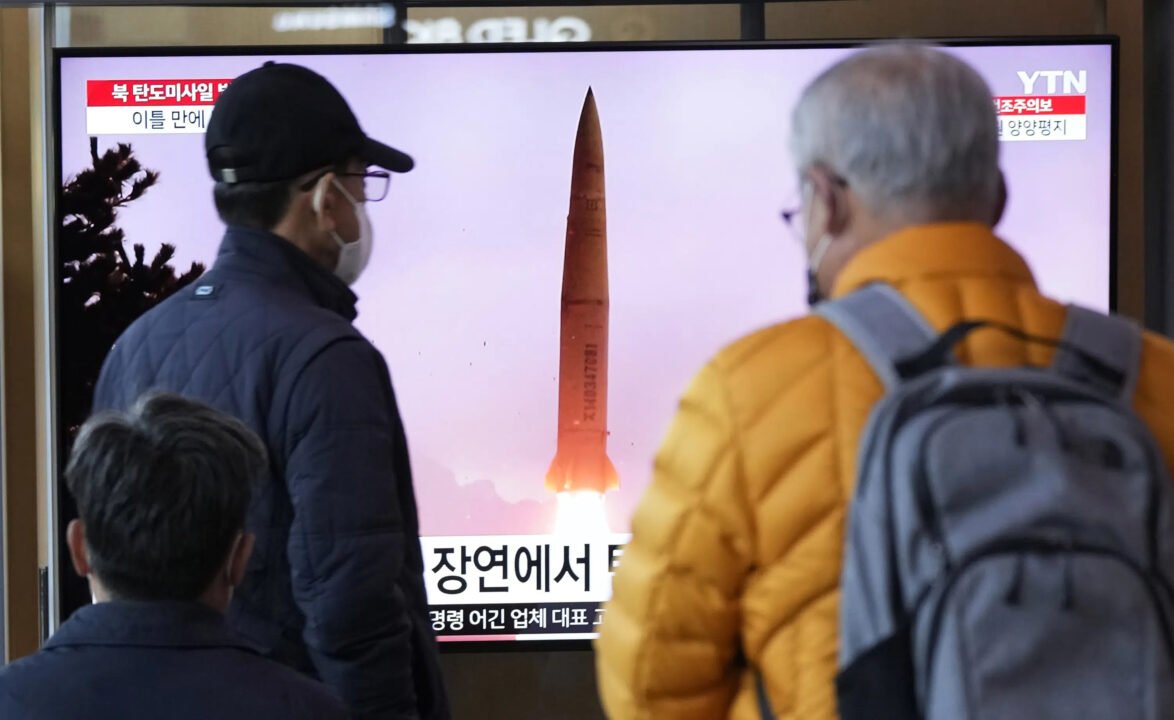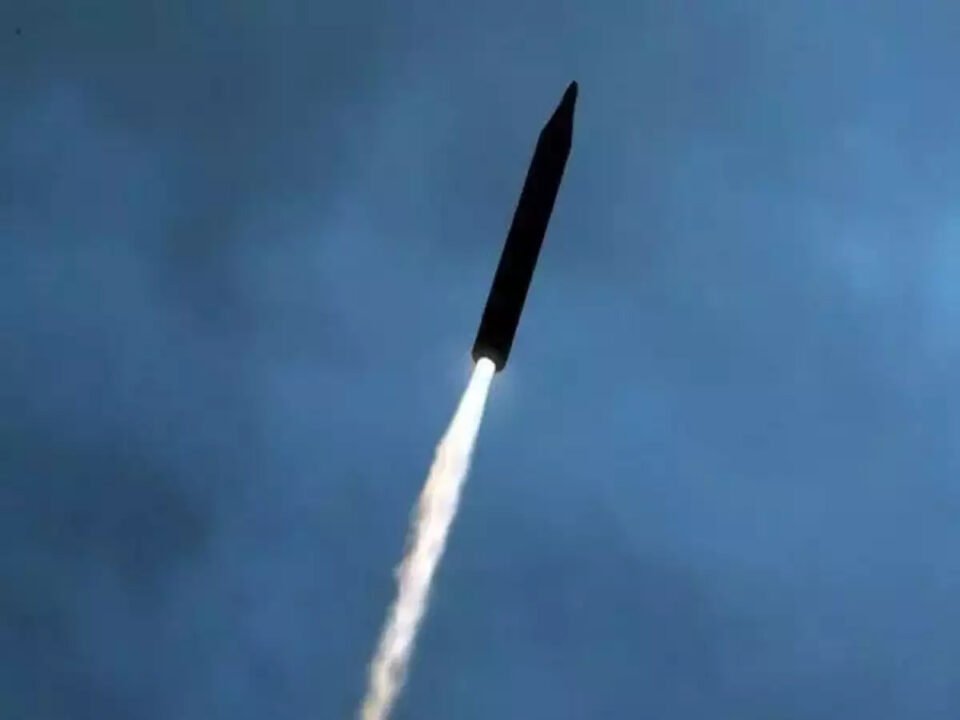SEOUL, March 17 (AP): North Korea said Friday it fired an intercontinental ballistic missile to “strike fear into the enemies” as South Korea and Japan agreed at a summit to work closely on regional security with the United States and staged military exercises around the region.
The missile was launched Thursday morning hours before South Korean President Yoon Suk Yeol met with Japanese Prime Minister Fumio Kishida at a summit partly aimed at rebuilding security ties between the U.S. allies in the face of North Korean nuclear threats.
With four missile displays in about a week, North Korea has ratcheted up its tit-for-tat response to ongoing U.S.-South Korean military drills that are the biggest of their kind in years.
The Biden administration wants better South Korea-Japan ties, which declined over historical issues in recent years, as it pushes to strengthen its alliance network in Asia to counter the North Korean nuclear threat and China’s rising influence.
Aside from their combined exercises that began Monday and run through March 23, the United States and South Korea are also participating in anti-submarine warfare drills, along with Japan, Canada and India, that began Wednesday.
North Korea’s official Korean Central News Agency said leader Kim Jong Un supervised the test-firing of the Hwasong-17 missile and stressed the need to “strike fear into the enemies” over what it called the “open hostility” shown to the North by the U.S.-South Korea exercises.
Launched at a high angle to avoid the territory of North Korea’s neighbors, the missile reached a maximum altitude of 6,045 kilometers (3,756 miles) and traveled 1,000 kilometers (621 miles) before landing in waters off the country’s eastern coast, KCNA said.
The South Korean and Japanese militaries assessed the flight similarly, indicating the U.S. mainland is within the missile’s range. It remains unclear whether North Korea has developed nuclear bombs small enough to fit on its long-range rockets or the technology to ensure its warheads survive atmospheric reentry when fired at a normal trajectory.
North Korea’s official Rodong Sinmun newspaper published photos of Kim watching from afar as the missile blasted off from a launch vehicle parked on an airport runway.
Kim was accompanied by a girl who appeared to be his daughter, believed to be named Kim Ju Ae and about 10 years old. She has accompanied him to several military events since she was publicly revealed for the first time during another ICBM launch in November. Analysts say the intent of her public appearances at military events is to tie the Kim family’s dynastic rule of North Korea to the nuclear arsenal Kim sees as the strongest guarantee of his survival.
Rodong Sinmun also published photos implied to have been taken by a camera on the missile as it soared into space. They showed a rounded view of the Earth, with clouds scattered over what appeared to be the Korean Peninsula and Asian coastline.
The photos were apparently intended as proof the missile would be capable of accurately striking its target, said Cheong Seong-Chang, a senior analyst at South Korea’s private Sejong Institute.
While all of North Korea’s ICBM tests have been conducted on a high angle, Cheong said the North is likely coming closer to launching one of those missiles at an angle closer to normal ballistic trajectory across the Pacific Ocean, in what would be one of its most provocative weapons demonstrations ever.
KCNA said the ICBM launch sends a “stronger warning” to North Korea’s rivals who are escalating tensions with their “frantic, provocative and aggressive large-scale war drills.” The test also was designed to confirm the reliability of the weapons system, KCNA said.
Kim said it’s crucial for North Korea’s nuclear missile forces to maintain readiness to counterattack rivals with “overwhelming offensive measures anytime” and make them realize their persistent and expanded military actions will “bring an irreversible, grave threat to them,” KCNA said.
Lee Hyojung, spokesperson of South Korea’s Unification Ministry, which handles inter-Korean affairs, said it’s deeply regrettable that the North continues to use the U.S.-South Korean military drills as an excuse to stage provocative military demonstrations.
“It’s clear that North Korea’s reckless nuclear and missile development is the cause of escalating tensions on the Korean Peninsula,” she said, urging Pyongyang to return to dialogue.
Speaking at a lecture in Singapore on Thursday, U.S. Indo-Pacific Command chief Adm. John Aquilino said China has a role to play in the world if it adheres to the rules-based order, especially in regards to North Korea, which depends on Beijing as its major ally and economic lifeline.
North Korea’s ramped-up weapons development, underscored by the dozens of missiles it test-fired last year, poses an increasing threat to South Korea and Japan and the country has also “developed the capabilities to threaten the United States as well,” Aquilino said.
“It is destabilizing, it’s unpredictable, it’s continuing, it’s not slowing down. The potential for the People’s Republic of China to help to dissuade the DPRK from executing these events would be helpful,” Aquilino said, using the initials of North Korea’s official name.
North Korea has long portrayed regular U.S.-South Korean military drills as rehearsals for a potential invasion, although the allies describe those exercises as defensive.
Many experts say North Korea uses its rivals’ drills as a pretext to aggressively expand its nuclear arsenal and overall military capability. They said it seeks to force the U.S. to accept the North’s status as a nuclear power and to negotiate ending sanctions against it from a position of strength.
Since last week, North Korea also has test-fired cruise missiles from a submarine and fired short-range missiles into the sea, attempting to show it could conduct potential nuclear strikes on both South Korean targets and the U.S. mainland.
Thursday’s launch was North Korea’s second of an ICBM this year. The Hwasong-15 launched in February is a slightly smaller weapon than the Hwasong-17.
At the summit between Yoon and Kishida, the leaders agreed to resume defense dialogue and further strengthen security cooperation with the United States to counter North Korea and other regional challenges.
“The ever-escalating threat of North Korea’s nuclear missile program poses a huge threat to peace and stability not only in East Asia but also to the (broader) international community,” Yoon said. “South Korea and Japan need to work closely together and in solidarity to wisely counter the threat.”












